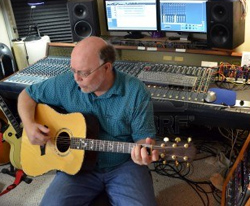
The Other Side
Now, for three reasons not to stereo-mic an acoustic guitar.
1. The guitar is cheap (or just doesn’t sound all that great.)
For several years I owned a fairly cheap Ibanez acoustic guitar. It didn’t sound awful, but it didn’t sound great. It was made out of a wood laminate and was lacking in the low end.
I tried recording that guitar with two mics, but it never gave me a much better sound.
If you think about it, it makes sense. One of the main reasons I proposed for stereo-miking acoustic guitar was the fact that it allows you to capture the entire instrument.
However, if the entire instrument doesn’t sound all that great, capturing more of the instrument won’t help.
In case you’re wondering, I was still able to get a decent recording out of that Ibanez. I used the proximity effect to my advantage. I would place a large-diaphragm condenser a couple inches from the 12th fret. The recording ended up having much more low end than the guitar itself normally had.
If you’re attempting to record a cheaper acoustic guitar, spend some time with a single microphone, find a “sweet spot,” and go from there.
2. You don’t want to deal with phase issues.
Since sound waves travel at a certain speed, any time you place two microphones on one source, there’s a chance that the sound waves will reach each microphone at a slightly different moment in time.
Any time this happens, the two tracks you’re recording are slightly out of phase, causing comb filtering to occur. There are technical charts and graphs out there that explain this in-depth.
However, what basically happens is the guitar sounds thin. Each microphone by itself may sound great, but when the two are played together, the guitar suddenly lacks depth and clarity.
It’s the same concept used in a phaser/flanger guitar pedal. The pedal delays the signal a bit and blends it with the original signal, causing that thin “phasey” sound. This sounds great on electric guitar, but it’s usually not what you’re looking for in acoustic guitar.
The way to avoid this is to make sure the two mics are an equal distance from a single point on the guitar. This is easier said than done, since guitarists are notorious for moving around from take to take, which could potentially add to the phase issues.
If you’re spending a lot of time getting the mics to play well together, then it may be time to go with a single mic and get back to recording.
3. The acoustic isn’t a prominent instrument in the song.
If the acoustic guitar is the central instrument of a song — perhaps in a singer-songwriter demo — then it makes sense to have that guitar be as big as possible.
However, if you’re working on a huge session, many times the acoustic guitar becomes a very small part of the overall mix. If you listen to a few songs on the radio, you’ll hear that the acoustic guitar oftentimes sounds very light and thin.
In these situations, since the acoustic is going to be heavily EQ’d and buried in the mix, it won’t make any difference to stereo-mic the guitar. Save yourself some time (and hard drive space) and just use a single microphone.
Joe Gilder is a Nashville-based engineer, musician, and producer who also provides training and advice at the Home Studio Corner. Note that Joe also offers highly effective training courses, including Understanding Compression and Understanding EQ.
